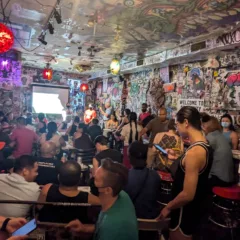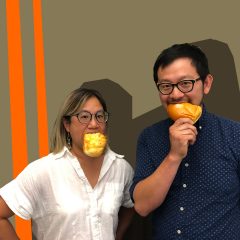Fleisher Art Memorial ends its season of Challenge exhibits with works that range from whimsical to nostalgic to earnestly activist. The Challenge shows have always been three emerging artist solo shows in one but if you work at it you can see a common thread running through the works. In this show, it’s all about relationships.
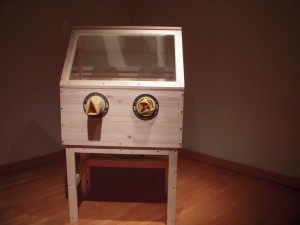
Constantina Zavitsanos’s is having a great time is all I have to say. Her basement-workshop aesthetic of low tech motors and fans, scavenged telephone parts, rubber gloves, watches, a compass, a chair and two video installations make her show a mini science fair with booths and stations but no posters to explain the projects. The little contraptions (some of which move, some don’t) are all quite mysterious. And because several of the pieces are interactive, it’s fun. You’d think there’d be a nostalgia in the works because of their used-parts charm but the work transcends nostalgia by sheer force of concept.
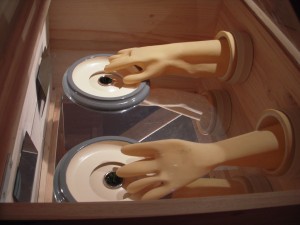
Conjuggle visit, which evokes an incubator or biohazard-study chamber is the one I played with most, slipping my hands into the rubber gloves and trying to ascertain what to do next. There’s nothing really. It’s all meta. The plates inside the chamber seem to contain little plots of grass in their center holes. You can see the grass but not really touch it since the gloves don’t go that far in. But the act of interacting and the quest for what to do inside the piece given there’s no instructions makes this a piece about frustration, loss and confusion. And because of the unreachable grass–which looks real but is an image of grass — the work seems to be about the inability of humankind to science its way out of the eco-hole we’re in.
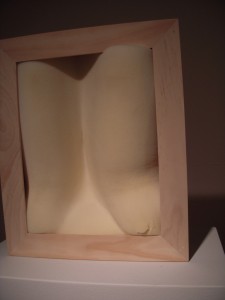
Elsewhere, the artist turns simple materials like memory foam into a double-sided self-portrait that bulges with sensuality. A round mirror on the floor reflects a wood trap door in the ceiling. The piece is called “escape patch,” and where you’d want to escape to is the question and why. But we’re so clearly in fantasy here, in Dr. Science’s secret workshop, that any story you make up will be the right one.
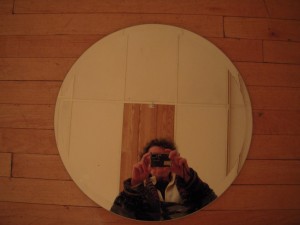
Relationships are hinted at in each piece. Relationships of the viewer to the piece; of the maker to the piece and to you; of the parts of the piece to each other. “with small fans (apart for the hole)” is the most directly relational work. A video projection in a corner of a little booth it shows what appear to be a lit candle on one side and a matchstick attached to a spinning fan on the other.
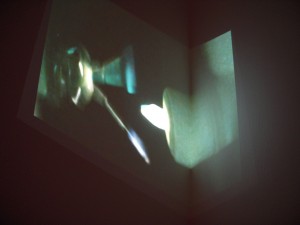
The matchstick dances wildly like a Samurai whirling dervish in front of the candle’s flame kissing it and playing with it but the candle burns bright and doesn’t seem to care. The active/passive two-step is a lovely piece to look at (and there’s a nice click-clack soundtrack as the fan speeds up and slows down). And while this could be yet another experiment in mechanics, the piece, like the rest of the show, reflects on all kinds of relationships including (and most importantly) human relationships. There’s no message beating you over the head about relationships. If anything, the artist seems to be saying, just pay attention.
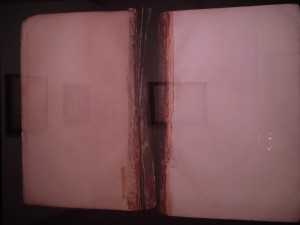
Johanna Inman’s series of photographs of ancient ripped-torn books also are about relationships. The books are in many cases splayed open and they wear their scars and blemishes on left and right sides of their spinal column, victims of time and misuse. The untitled photos are large (30×40″ down to 20×20″) so you can see all the wounds clearly. And because the books have blank pages (or are opened to blank pages) they are generic representations whose interest lies simply in their physical beings. These are not books as books but books as generic old things. The pages read as skin and the darkened channels of ancient dried glue are so much blood so there’s a humanness implied. There’s also nostalgia for the past and fascination with the beautiful ruin. You can’t judge a book by its cover and here you can’t judge it by its insides either. Somehow, I want to know more about the books’ contents.
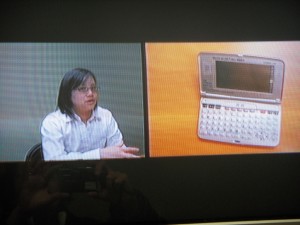
Yvonne Lung’s video, installed in a little room inside Fleisher’s small back chamber (the first time I’ve seen a room built in this space) is a piece of art activism. The artist, who is a Mandarin interpreter in US Immigration Court, interviewed members of Philadelphia’s Chinese community about their immigrant experience. In the split-screen video, there is footage taken at the actual interviews with Lung’s on the spot translations of the stories. Opposite screen the artist on the split screen is an image central to the story being told. The video is very long. During my visit to the gallery, Lung was on one story the whole time I was there. The meta-documentary approach, where the artist plays the role of someone she interviewed, is a great idea. But unless you’re using Hollywood storytelling techniques (ala Ryan Trecartin) to keep your audience enthralled, it’s asking a lot of a viewer to watch for longer than 3 minutes.


